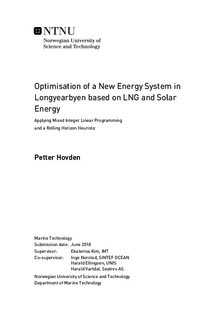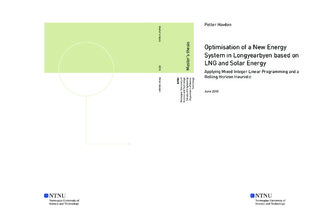| dc.description.abstract | Longyearbyen is an isolated, Arctic settlement, where the energy situation is facing changes in near future. Today s energy system in Longyearbyen is a stand-alone system, consisting of a coal power plant as primary power producer and a diesel reserve system as a backup. In addition, the energy system offers fuel supply to the marine traffic in Longyearbyen, mainly Marine Gas Oil (MGO). The Ministry of Petroleum and Energy is currently assessing the possibilities for new energy carriers in Longyearbyen, and the general focus is that the new system should be more environmentally friendly than today s system.
LMG Marin is a company that is currently designing a solution applicable to the changes Longyearbyen is facing, and has given the inspiration for the problem description in this thesis. The energy carriers in the new energy system in Longyearbyen is Liquefied Natural Gas (LNG) and solar energy. The aim of this thesis has been to create an optimisation model intended to minimize the total lifetime costs over a 30-year period for the new energy system in Longyearbyen.
The optimisation model in this thesis has been formulated by applying Mixed Integer Linear Programming, and implemented in the linear solver FICO® Xpress. A Rolling Horizon Heuristic algorithm was created to reduce the computational time of the model to an applicable level. The optimisation model was successfully validated in cooperation with the industry partners, and concluded to reflect the energy system realistically.
An economic and environmental study were conducted to see the cost and emission effects of different system designs. The results were based on future energy demand predictions in Longyearbyen. The predictions assumed an electricity demand reduction of 25% due to the removal of the coal power plant, and a reduction of the heat demand with 40% due to energy efficiency actions. The LNG ship bunkering demand corresponded to 80% of today s MGO demand, and the solar irradiance level was assumed to remain at today s level. Four different energy system designs were investigated:
- With LNG storage and LNG power plant
- With LNG storage, LNG power plant, battery, thermal storage and heat pump
- With LNG storage, LNG power plant, battery, thermal storage, heat pump and solar park
- With LNG storage, LNG power plant, 50 MWh battery, thermal storage, heat pump and solar park
The economic study concluded that it is advantageous to invest in a battery, thermal storage and heat pump to enhance the efficiency of the system, because it potentially can reduce the total lifetime costs of the new energy system with almost 50 million USD compared with the system with only the power plant for power production. If installing the solar park in addition to that system, it is possible to reduce the total lifetime costs with another 24 million USD.
An environmental study was conducted analysing the same four system designs as mentioned above. The conclusion was that by changing the power production from coal to LNG and the marine fuel from MGO to LNG, it is possible to reduce the CO2 emission with at least 60%. In addition, by implementing energy efficiency-enhancing components, such as a battery, thermal storage, and heat pump, in addition to the solar park, the CO2 emissions can be further reduced by around 36% compared with the LNG power plant alone. Notice that this is also the most cost-effective design. Installing a battery of 50 MWh will reduce the emissions with another 6%, but it will be 23 million USD costlier than the most cost-effective design. | |

